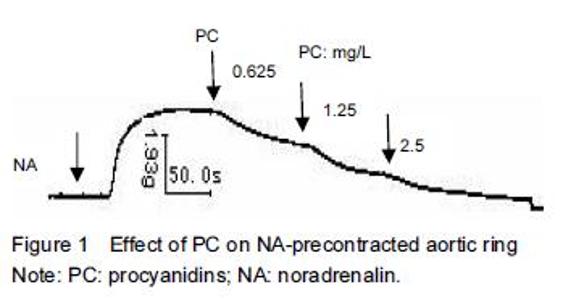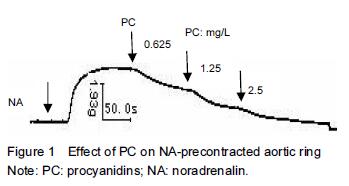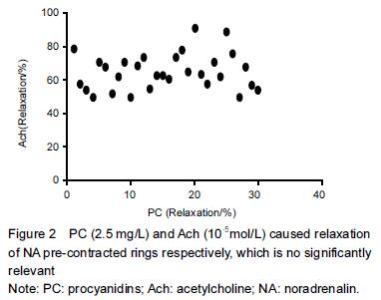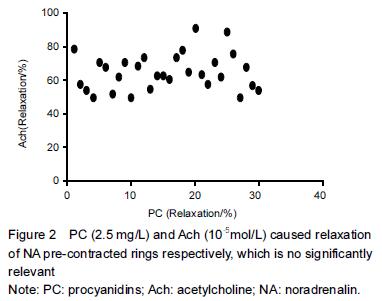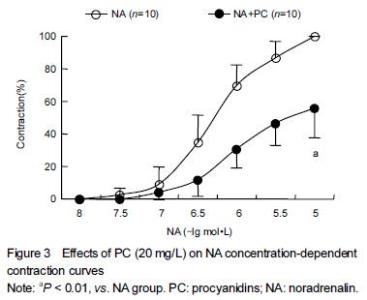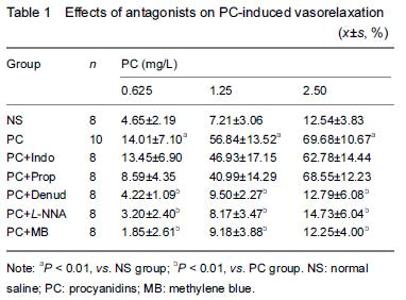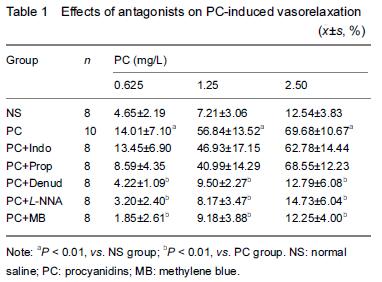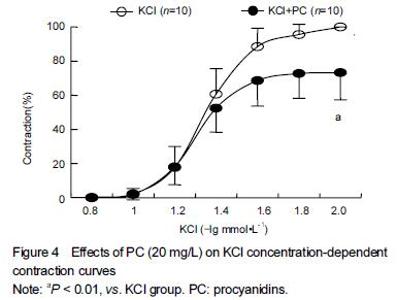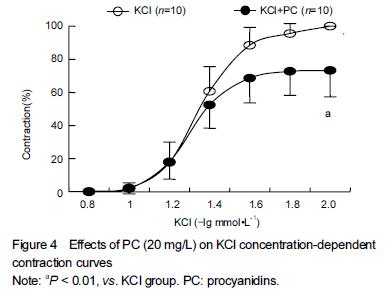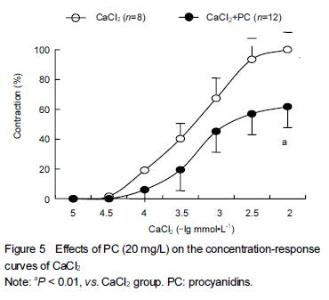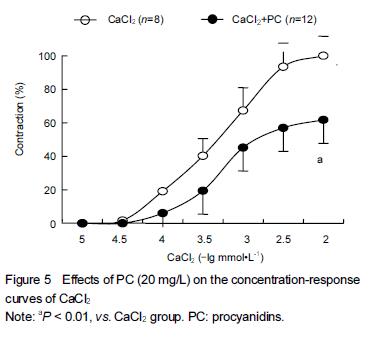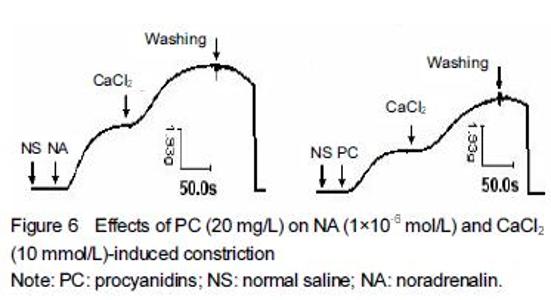Chinese Journal of Tissue Engineering Research ›› 2016, Vol. 20 ›› Issue (18): 2668-2676.doi: 10.3969/j.issn.2095-4344.2016.18.013
Previous Articles Next Articles
Vasorelaxant effects of procyanidins on pulmonary artery in vitro
Niu Cai-qin1, Sun An2, Lei Xiao1, Zhang Tuan-xiao3
- 1 Clinical Department of Chinese and Western Medicine, North Sichuan Medical College, Nanchong 637007, Sichuan Province, China
2 Lanzhou Military Region Air Force Hospital Authority, Lanzhou 730020, Gansu Province, China3 Department of Physiology, North Sichuan Medical College, Nanchong 637007, Sichuan Province, China
-
Received:2016-02-14Online:2016-04-29Published:2016-04-29 -
Contact:Zhang Tuan-xiao, Master, Professor, Department of Physiology, North Sichuan Medical College, Nanchong 637007, Sichuan Province, China -
About author:牛彩琴,女,1970年生,汉,甘肃省会宁县人,2005年甘肃中医学院毕业,硕士,副教授,主要从事中西医基础与临床方面的研究。 -
Supported by:the Key Program of Sichuan Department of Education, No. 14ZA0182
Cite this article
Niu Cai-qin, Sun An, Lei Xiao, Zhang Tuan-xiao. Vasorelaxant effects of procyanidins on pulmonary artery in vitro[J]. Chinese Journal of Tissue Engineering Research, 2016, 20(18): 2668-2676.
share this article
| [1] Zhang Y, Wu XX. Research progress on procyanidins. Zhongyao Yaoli yu Linchuang ZaZhi. 2011;27(6): 112-116. [2] Lelono RA, Tachibana S. Bioassay-guided isolation and identification of antioxidative compounds from the bark of Eugenia polyantha. Pak J Biol Sci. 2013;16(16): 812-818. [3] Monagas M, Quintanilla-López JE, Gómez-Cordovés C, et al. MALDI-TOF MS analysis of plant proanthocyanidins. J Pharm Biomed Anal. 2010;51(2):358-372. [4] Sun CF. Research progress on procyanidins. Shipin yu Jixie. 2010;26(4):146-152. [5] Vitseva O, Varghese S, Chakrabarti S, et al. Grape seed and skin extracts inhibit platelet function and release of reactive oxygen intermediates. J Cardiovasc Pharmacol. 2005;46(4):445-451. [6] Bayatli F, Akku? D, Kilic E, et al. The protective effects of grape seed extract on MDA, AOPP, apoptosis and eNOS expression in testicular torsion: an experimental study. World J Urol. 2013;31(3):615-622. [7] Serra AT, Rocha J, Sepodes B, et al. Evaluation of cardiovascular protective effect of different apple varieties - Correlation of response with composition. Food Chem. 2012;135(4):2378-2386. [8] Tyagi A, Raina K, Gangar S, et al. Differential effect of grape seed extract against human non-small-cell lung cancer cells: the role of reactive oxygen species and apoptosis induction. Nutr Cancer. 2013;65 Suppl 1: 44-53. [9] Charradi K, Elkahoui S, Karkouch I, et al. Grape seed and skin extract alleviates high-fat diet-induced renal lipotoxicity and prevents copper depletion in rat. Appl Physiol Nutr Metab. 2013;38(3):259-267. [10] Nishizuka T, Fujita Y, Sato Y, et al. Procyanidins are potent inhibitors of LOX-1: a new player in the French Paradox. Proc Jpn Acad Ser B Phys Biol Sci. 2011; 87(3):104-113. [11] Wang JS, Zhao J, Lv WJ, et al. Study on fillet quality of pseudosciaena crocea dip by oligomeric proanthocyanidins during cold storage. Zhongguo Shipin Xuebao. 2013;13(2):130-136. [12] Harrison DG, Gongora MC. Oxidative stress and hypertension. Med Clin North Am. 2009;93(3): 621-635. [13] Zhang H, Yerigui, Yang Y, et al. Structures and antioxidant and intestinal disaccharidase inhibitory activities of A-type proanthocyanidins from peanut skin. J Agric Food Chem. 2013;61(37):8814-8820. [14] Sivaprakasapillai B, Edirisinghe I, Randolph J, et al. Effect of grape seed extract on blood pressure in subjects with the metabolic syndrome. Metabolism. 2009;58(12):1743-1746. [15] Belcaro G, Ledda A, Hu S, et al. Grape seed procyanidins in pre- and mild hypertension: a registry study. Evid Based Complement Alternat Med. 2013; 2013:313142. [16] Auger C, Chaabi M, Anselm E, et al. The red wine extract-induced activation of endothelial nitric oxide synthase is mediated by a great variety of polyphenolic compounds. Mol Nutr Food Res. 2010; 54 Suppl 2: S171-183. [17] Holt RR, Heiss C, Kelm M, et al. The potential of flavanol and procyanidin intake to influence age-related vascular disease. J Nutr Gerontol Geriatr. 2012;31(3):290-323. [18] Zhao G, Gao H, Qiu J, et al. The molecular mechanism of protective effects of grape seed proanthocyanidin extract on reperfusion arrhythmias in rats in vivo. Biol Pharm Bull. 2010;33(5):759-767. [19] Ding P, Xu YM, Qin FP. Research on antioxidant activities and optimization of process for micro- encapsulation of Lithospermum erythrorhizon using β-cyclodextrin.Shipin Gongye Keji. 2009;30(2): 184-188. [20] Lewandowska U, Szewczyk K, Owczarek K, et al. Procyanidins from evening primrose (Oenothera paradoxa) defatted seeds inhibit invasiveness of breast cancer cells and modulate the expression of selected genes involved in angiogenesis, metastasis, and apoptosis. Nutr Cancer. 2013;65(8):1219-1231. [21] Liu XH, Mai WL, Zheng Q, et al. Effects of proanthocyanidins on nerve conduction velocity of type 2 diabetes rats. Chuanbei Yixueyuan Xuebao. 2014;29(5):429-431. [22] Zhang TX, He D, Niu CQ, et al. Vasodilation of procyanidins from grape seeds on isolated rabbit aorta. Zhongcaoyao. 2006;37(1):87-89. [23] Nyhan D, Gaine S, Hales M, et al. Pulmonary vascular endothelial responses are differentially modulated after cardiopulmonary bypass. J Cardiovasc Pharmacol. 1999;34(4):518-525. [24] Chen L, Lv Z. Study on effects of insulin on senescence and Akt expression of endothelial cell. Chuanbei Yixueyuan Xuebao. 2013;28(6):540-543. [25] Li HF, Wang LD, Tian ZF, et al. Effects of phytoestrogens resveratrol and phloretin on contractile response of aortic strips in rabbits. Zhongguo Yaolixue yu Dulixue Za Zhi. 2006;20(1):26-32. [26] Niu CQ, Mai WL, Zhang TX. Contraction effects of Total alkali sophora alopecuroids on rat’s sinus ventriculi circular muscle in vitro. Sichuan Zhongyi. 2012;30(11): 55-58. [27] Zhang T, Niu C, Lan H, et al. Vasorelaxant effects of procyanidins on rabbit pulmonic ring in vitro. Zhongguo Zhong Yao Za Zhi. 2009;34(21): 2813-2816. [28] Zhang H, Wang F. Study on the effects of ethanol extract of spatholobus suberectus on platelet aggregation and isolated vascular. Zhongguo Yaofang. 2013;35(24):3271-3273. [29] Xu DZ, Zhao DY. Procedures for estimating pharmaco-receptor parameters,pD2,pA2,and pD2’ including a common computer program. Shanghai Diyi Yixueyuan Xuebao. 1985;12(5):342-349. [30] Schramm DD, Wang JF, Holt RR, et al. Chocolate procyanidins decrease the leukotriene-prostacyclin ratio in humans and human aortic endothelial cells. Am J Clin Nutr. 2001;73(1):36-40. [31] Karim M, McCormick K, Kappagoda CT. Effects of cocoa extracts on endothelium-dependent relaxation. J Nutr. 2000;130(8S Suppl):2105S-2108S. [32] Kim SH, Kang KW, Kim KW, et al. Procyanidins in crataegus extract evoke endothelium-dependent vasorelaxation in rat aorta. Life Sci. 2000;67(2): 121-131. [33] Fitzpatrick DF, Bing B, Maggi DA, et al. Vasodilating procyanidins derived from grape seeds. Ann N Y Acad Sci. 2002;957:78-89. [34] Aldini G, Carini M, Piccoli A, et al. Procyanidins from grape seeds protect endothelial cells from peroxynitrite damage and enhance endothelium- dependent relaxation in human artery: new evidences for cardio-protection. Life Sci. 2003; 73(22): 2883-2898. [35] Komori K, Suzuki H. Heterogeneous distribution of muscarinic receptors in the rabbit saphenous artery. Br J Pharmacol. 1987;92(3):657-664. [36] Yue P, Lü YJ, Yang BF. Advances in the study of cardiac M3 receptor as a novel target of antiarrhythmic drugs. Yao Xue Xue Bao. 2006;41(8): 702-705. [37] Hammarström AK, Parkington HC, Coleman HA. Release of endothelium-derived hyperpolarizing factor (EDHF) by M3 receptor stimulation in guinea-pig coronary artery. Br J Pharmacol. 1995; 115(5):717-722. [38] Shi H, Wang H, Li D, et al. Differential alterations of receptor densities of three muscarinic acetylcholine receptor subtypes and current densities of the corresponding K+ channels in canine atria with atrial fibrillation induced by experimental congestive heart failure. Cell Physiol Biochem. 2004;14(1-2):31-40. [39] Wang S, Han HM, Jiang YN, et al. Activation of cardiac M3 muscarinic acetylcholine receptors has cardioprotective effects against ischaemia-induced arrhythmias. Clin Exp Pharmacol Physiol. 2012; 39(4):343-349. [40] Wang T, Hogan-Cann A, Kang Y, et al. Muscarinic receptor activation increases hERG channel expression through phosphorylation of ubiquitin ligase Nedd4-2. Mol Pharmacol. 2014;85(6):877-886. [41] Liu Y, Wang S, Wang C, et al. Upregulation of M? muscarinic receptor inhibits cardiac hypertrophy induced by angiotensin II. J Transl Med. 2013;11:209. [42] Shan LM, Wang H. Pharmacological characteristics of the endothelial target for acetylcholine induced vascular relaxation. Life Sci. 2002;70(11):1285-1298. [43] Qi YM, Yang DJ, Duan X, et al. Endomorphins inhibit contractile responses of rat thoracic aorta rings induced by phenylephrine and angiotensin II in vitro. Acta Pharmacol Sin. 2002;23(1):40-44. [44] Furuuchi R, Sakai H, Hirokawa N, et al. Antihypertensive effect of boysenberry seed polyphenols on spontaneously hypertensive rats and identification of orally absorbable proanthocyanidins with vasorelaxant activity. Biosci Biotechnol Biochem. 2012;76(9):1694-1701. [45] Zhang TX, Niu CQ, Hu JM, et al. Vasorelaxational effects of procyanidins on rabbit aorta in vitro and decreasing arterial blood pressure in vivo. Zhongguo Zhong Yao Za Zhi. 2008;33(14):1720-1723. [46] Wu X, Guo RN, Guo RZ, et al. Effects of grape seed procyanidin on blood pressure in renovascular hypertensive rats. Zhongguo Binglixue Zazhi .2011; 27(3):593-595. [47] Martin W, Villani GM, Jothianandan D, et al. Selective blockade of endothelium-dependent and glyceryl trinitrate-induced relaxation by hemoglobin and by methylene blue in the rabbit aorta. J Pharmacol Exp Ther. 1985;232(3):708-716. [48] Zhang JJ, Pu Y, Li Y. Influence of PI3K and MAPKs signaling pathways on expression of VEGF in human pancreatic cancer PANC-1 cells. Chuanbei Yixueyuan Xuebao. 2014;29(1):44-48. [49] Ruan GX, Kazlauskas A. Axl is essential for VEGF-A- dependent activation of PI3K/Akt. EMBO J. 2012; 31(7): 1692-1703. [50] Ruan GX, Kazlauskas A. VEGF-A engages at least three tyrosine kinases to activate PI3K/Akt. Cell Cycle. 2012;11(11):2047-2048. [51] Iwamoto Y, Ohishi M, Yuan M, et al. β-Adrenergic receptor gene polymorphism is a genetic risk factor for cardiovascular disease: a cohort study with hypertensive patients. Hypertens Res. 2011;34(5): 573-577. [52] Lei KI, Huang XN, Wu Q, et al. Bre inhibited[Ca2+]i elevaton induced by NA while enhanced tat induced by kalium chloride. Chuanbei Yixueyuan Xuebao. 2004;19(4):6-7. [53] Martel G, Hamet P, Tremblay J. Central role of guanylyl cyclase in natriuretic peptide signaling in hypertension and metabolic syndrome. Mol Cell Biochem. 2010;334(1-2):53-65. [54] Liu B, Liu J, Jian SH, et al. Expression and significance of Eag1, HIF-1α and VEGF in cervical cancer. Chuanbei Yixueyuan Xuebao. 2014;29(1): 57-62. [55] Morgado M, Cairrão E, Santos-Silva AJ, et al. Cyclic nucleotide-dependent relaxation pathways in vascular smooth muscle. Cell Mol Life Sci. 2012;69(2): 247-266. [56] Jiang YG, Wang H. Potassium channels and the modulators in vascular smooth muscle cells. Zhongguo Yaolixue Tongbao. 2002;18(5):494-497. [57] Shen W, Wang H. Regulation of eNOS phosphorylation by natakalim via activating ATP-sensitive potassium channel subtype SUR2B/Kir6.1 in endothelial cells. Yaolixue Tongbao. 2014;30(2):229-232. [58] Zhang XY, Li WG, Gao MT. Protective effect on injured myocardial cells of proanthoc yanidins in vitro. Zhongyao Yaoli yu Linchuang. 2001;17:14-17. [59] Ling ZQ, Xie BJ, Jiang T. Protective effects of procyanidins' extract from the lotus' seedpod on experimental myocadial injury in rat. Zhongguo Yaolixue Tongbao. 2001;17(6):687-690. |
| [1] | Pu Rui, Chen Ziyang, Yuan Lingyan. Characteristics and effects of exosomes from different cell sources in cardioprotection [J]. Chinese Journal of Tissue Engineering Research, 2021, 25(在线): 1-. |
| [2] | Jiang Xin, Qiao Liangwei, Sun Dong, Li Ming, Fang Jun, Qu Qingshan. Expression of long chain non-coding RNA PGM5-AS1 in serum of renal transplant patients and its regulation of human glomerular endothelial cells [J]. Chinese Journal of Tissue Engineering Research, 2021, 25(5): 741-745. |
| [3] | Jiang Tao, Ma Lei, Li Zhiqiang, Shou Xi, Duan Mingjun, Wu Shuo, Ma Chuang, Wei Qin. Platelet-derived growth factor BB induces bone marrow mesenchymal stem cells to differentiate into vascular endothelial cells [J]. Chinese Journal of Tissue Engineering Research, 2021, 25(25): 3937-3942. |
| [4] | Chen Siqi, Xian Debin, Xu Rongsheng, Qin Zhongjie, Zhang Lei, Xia Delin. Effects of bone marrow mesenchymal stem cells and human umbilical vein endothelial cells combined with hydroxyapatite-tricalcium phosphate scaffolds on early angiogenesis in skull defect repair in rats [J]. Chinese Journal of Tissue Engineering Research, 2021, 25(22): 3458-3465. |
| [5] | Mo Jianling, He Shaoru, Feng Bowen, Jian Minqiao, Zhang Xiaohui, Liu Caisheng, Liang Yijing, Liu Yumei, Chen Liang, Zhou Haiyu, Liu Yanhui. Forming prevascularized cell sheets and the expression of angiogenesis-related factors [J]. Chinese Journal of Tissue Engineering Research, 2021, 25(22): 3479-3486. |
| [6] | Cao Yang, Zhang Junping, Peng Li, Ding Yi, Li Guanghui. Isolation and culture of rabbit aortic endothelial cells and biological characteristics [J]. Chinese Journal of Tissue Engineering Research, 2021, 25(19): 3000-3003. |
| [7] | Wang Huili, Chen Zhijiang, Wu Bingyi. Glia maturation factor-gamma inhibits the proliferation of human colorectal cancer LoVo cells and affects the cytoskeletal motion of human umbilical vein endothelial cells [J]. Chinese Journal of Tissue Engineering Research, 2021, 25(13): 2055-2059. |
| [8] | Liu Tao, Zhang Nini, Huang Guilin . Relationship between extracellular vesicles and radiation-induced tissue injury [J]. Chinese Journal of Tissue Engineering Research, 2021, 25(13): 2121-2126. |
| [9] | Fan Haixia, Tan Qingkun, Wang Hong, Cheng Huanzhi, Liu Xue, Ching-chang Ko, Geng Haixia. Rabbit skull defects repaired by the hydroxyapatite/geltin scaffold combined with bone marrow mesenchymal stem cells and umbilical vein endothelial cells [J]. Chinese Journal of Tissue Engineering Research, 2021, 25(10): 1495-1499. |
| [10] | Gu Jingjing, Zhou Rui, Yang Tingting, Yang Xiaoping, Xu Fei, Zheng Bo. Supporting effect of human skeletal muscle-derived myoendothelial cells on hematopoietic stem/progenitor cells in vitro [J]. Chinese Journal of Tissue Engineering Research, 2021, 25(1): 50-55. |
| [11] | Zhang Jian, Chen Miao, Li Weixin, Ye Yichao, Xu Huiyou, Ma Ke, Chen Xuyi, Sun Hongtao, Zhang Sai. Collagen/heparin sulfate scaffolds loaded with brain-derived neurotrophic factor promote neurological and locomotor function recovery in rats after traumatic brain injury [J]. Chinese Journal of Tissue Engineering Research, 2020, 24(34): 5538-5544. |
| [12] | Chen Jia, Yang Yiqiang, Hu Chen, Chen Qi, Zhao Tian, Yong Min, Ma Dongyang, Ren Liling. Fabrication of prevascularized osteogenic differentiated cell sheet based on human bone marrow mesenchymal stem cells and human umbilical vein endothelial cells [J]. Chinese Journal of Tissue Engineering Research, 2020, 24(31): 4934-4940. |
| [13] | Cao Baichuan, Zeng Gaofeng, Gao Yunbing, Deng Guiying, Cen Zhongxi, Zhang Chuanyang, Guo Yande, Zong Shaohui. Heat-shock endothelial cells induce differentiation of bone marrow mesenchymal stem cells into vascular endothelial cells [J]. Chinese Journal of Tissue Engineering Research, 2020, 24(19): 3023-3028. |
| [14] | Cao Yang, Hu Ping, Tian Min, Wei Fang, Gu Qing, Lü Hongbin. Effects of 6-phosphofructokinase-2/fructose-2,6-bisphosphatase 3 on tubule formation of human umbilical vein endothelial cells [J]. Chinese Journal of Tissue Engineering Research, 2020, 24(14): 2217-2222. |
| [15] | Zhao Jianfeng, Geng Yu, Chen Qianbo, Yang Jinghui, Li Yan. Changes in insulin resistance and inflammatory factors in cataract patients with glaucoma after phacoemulsification and trabeculectomy: a self-controlled trial [J]. Chinese Journal of Tissue Engineering Research, 2020, 24(11): 1750-1755. |
| Viewed | ||||||
|
Full text |
|
|||||
|
Abstract |
|
|||||
